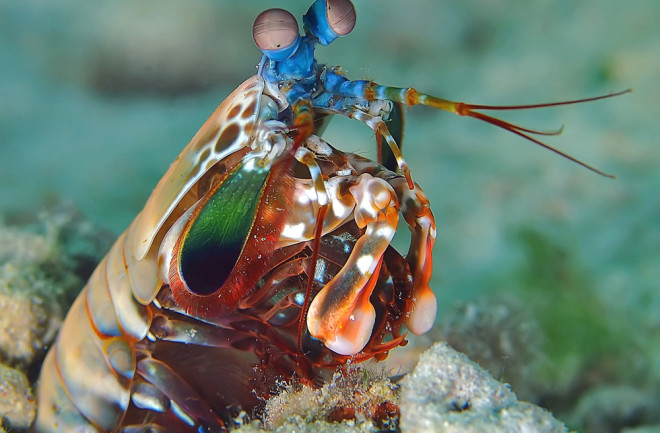Mantis shrimp — four-inch long seafloor crustaceans — knock out prey with a punch that accelerates faster than a .22 caliber bullet. Now, researchers have figured out exactly how the tiny stomatopods wind up their forceful blows. It’s all thanks to a double-layered saddle-shaped spring made from surprisingly brittle material.
“If you asked a mechanical engineer to make a spring that can store a lot of elastic energy, they wouldn’t think of using ceramic,” Ali Miserez, a materials scientist at Nanyang Technological University in Singapore who led the new research, said in a statement. Ceramics are normally thought of as inflexible and shatter-prone, not the kind of material you’d want for something that bends and deforms.
But it’s true: A ceramic spring allows mantis shrimp to unleash their club-like forearms at speeds of more than 50 miles per hour.
“Ceramics can store energy if you deform
them, but they’re so brittle that it wouldn’t be intuitive,” Miserez added. “But if you compress them, they’re quite strong and stiffer than metal or any polymer, so you can actually store a higher amount of energy than you could with those materials.”
Saddle Spring
Ideally, the best springs — the ones that can hold the most energy — are both stiff and extendable. As far as materials go, these characteristics typically don’t go hand in hand: They are either stiff or they are extendable. To overcome this challenge, the mantis shrimp’s saddle-shaped spring has two layers. The top layer is a mineralized bioceramic material similar to bone, whereas the bottom layer is fibrous, like a rope. Miserez and colleagues thought this design might enable maximum energy storage in the shrimp’s saddle and simultaneously prevent the brittle ceramic material from breaking.
The researchers measured the mechanical properties of each layer and made a model of the mantis shrimp’s punch. Their analysis revealed the outer layer of the spring stores the elastic energy the shrimp need to hurl their famously fast wallops. The inner layer, which is strongest when stretched, provides necessary flexible support. Without the extendable inner layer, the mantis shrimp’s death-wielding spring would fail, the researchers report today in the journal iScience.
Inspired Design
The saddle’s design also allows the spring to be used repeatedly without wearing out the parts, the scientists found. The discovery reveals a way to improve microrobotics, staple-sized robots that DARPA and other organizations are developing to enable rescue personnel to safely survey rubble after natural disasters, among other applications.
“What this design shows is that you can make a very efficient spring — and you can make it out of ceramics, which are more efficient than other materials people are using now,” Miserez said. Ceramic-based springs and other bioinspired design elements could make microrobots more efficient.

